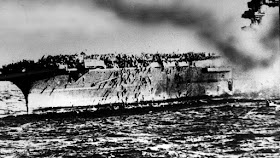Localizado los restos del
USS Lexington
USS Lexington 1938
Se han necesitado 76 años para localizar los restos del portaviones
estadounidense USS Lexington (CV-2).
La expedición ha sido dirigida por el cofundador de Microsoft, Paull Allen. El portaaviones
fue hundido durante la batalla del Mar del Coral el 8 de mayo de 1942, la
primera batalla aeronaval de portaaviones de la historia.
El USS Lexington fue diseñado originalmente como crucero pero en 1925 fue
reconvertido en portaaviones con el objetivo de proveer a la US Navy de estos
importantes navíos. Durante la batalla del Mar del Coral se enfrentó, junto al
portaaviones USS Yorktown a parte de
la flota japonesa. Durante la mañana del 8 de mayo un avión de reconocimiento
norteamericano localizó al portaviones japonés IJN Shōkaku y a su escolta. De inmediato se lanzó un
grupo de ataque sobre la flota japonesa. A las 11:00 le tocó el turno a los
japoneses y 20 minutos más tarde el USS Lexington comenzó a retirarse al encajar dos torpedos. Poco después
otro grupo de bombarderos en picado lo volverían a alcanzar con dos bombas, una
de ellas impactando en el castillo. Los daños provocaron un incendio catastrófico
a pesar de los esfuerzos de las cuadrillas de control de daños. A las 17:01 el
capitán Frederick Carl Sherman ordenó abandonar el portaaviones. Un total de
2.770 tripulantes fueron recogidos por los cruceros y destructores de escolta. A
las 19:56 el USS Lexington
desapareció bajo las aguas entre explosiones y una gran humareda llevándose al
fondo del mar a 216 marineros.
La expedición dirigida por Paull
Allen ha localizado los restos del portaaviones a 3.000 metros y a unos 800
kilómetros de la costa Australiana. Según declaraciones de Robert Krafr (director de operaciones submarinas del proyecto) descubrir los restos de este coloso se mantuvo siempre entre
sus objetivos primordiales y no ha sido el único naufragio que han
localizado. Han podido dar con los restos de varios barcos más, como por ejemplo
el USS Indianapolis.
Fuentes:
BROWN. J. “Carrier
Operations in World War II” Naval
Institute Press, 2009
STEM, R. “The Lexington Class
Carriers” Naval Institute Press, 1993
R/V Petrel
English version
It took 76 years to locate the remains of the USS Lexington aircraft
carrier (CV-2). The
expedition has been directed by the co-founder of Microsoft, Paull Allen. The
aircraft carrier was sunk during the Battle of the Coral Sea on May 8, 1942,
the first aircraft carrier battle in history.
The USS Lexington was originally designed as a cruise ship but in 1925 it was converted into an aircraft carrier with the objective of providing the US Navy with these important ships. During the battle of the Sea of the Coral it faced, next to the aircraft carrier USS Yorktown to part of the Japanese fleet. On the morning of May 8, an American reconnaissance aircraft located the Japanese aircraft carrier IJN Shōkaku and his escort. Immediately an attack group was launched on the Japanese fleet. At 11:00 it was the turn of the Japanese and 20 minutes later the USS Lexington began to retreat by fitting two torpedoes. Shortly after, another group of dive bombers would reach it again with two bombs, one of them hitting the castle. The damage caused a catastrophic fire despite the efforts of the damage control crews. At 17:01 Captain Frederick Carl Sherman ordered to leave the aircraft carrier. A total of 2,770 crew members were picked up by the escort cruisers and destroyers. At 19:56 the USS Lexington disappeared under the waters between explosions and a large smoke, taking to the bottom of the sea 216 sailors.
The expedition led by Paull Allen has located the remains of the aircraft carrier at 3,000 meters and about 800 kilometers from the Australian coast. According to Robert Krafr (director of submarine operations of the project) discovering the remains of this colossus always remained among its primary objectives and has not been the only shipwreck they have located. They have been able to find the remains of several other ships, such as the USS Indianapolis.
Sources:
BROWN. J. “Carrier
Operations in World War II” Naval
Institute Press, 2009
STEM, R. “The Lexington Class
Carriers” Naval Institute Press, 1993
R/V Petrel


